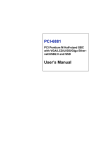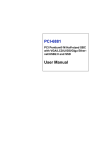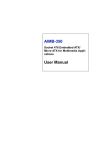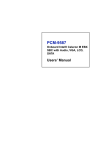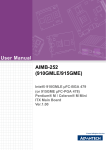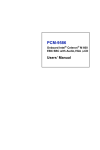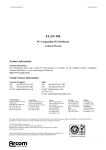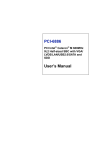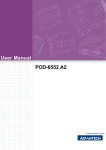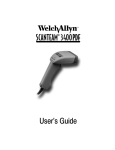Download Advantech POD-6552 A2 User`s manual
Transcript
POD-6552 5.25” Intel® Celeron® M SBC, with CPU/ VGA/LCD, and Ethernet Interface User’s Manual Copyright This document is copyrighted, © 2005. All rights are reserved. The original manufacturer reserves the right to make improvements to the products described in this manual at any time without notice. No part of this manual may be reproduced, copied, translated or transmitted in any form or by any means without the prior written permission of the original manufacturer. Information provided in this manual is intended to be accurate and reliable. However, the original manufacturer assumes no responsibility for its use, nor for any infringements upon the rights of third parties that may result from such use. Acknowledgements Award is a trademark of Award Software International, Inc. IBM, PC/AT, PS/2 and VGA are trademarks of International Business Machines Corporation. Intel and Celeron are trademarks of Intel Corporation. Microsoft Windows® is a registered trademark of Microsoft Corp. RTL is a trademark of Realtek Semi-Conductor Co., Ltd. ESS is a trademark of ESS Technology, Inc. UMC is a trademark of United Microelectronics Corporation. SMI is a trademark of Silicon Motion, Inc. All other product names or trademarks are properties of their respective owners. For more information on this and other Advantech products, please visit our websites at: http://www.advantech.com http://www.advantech.com/eplatform For technical support and service, please visit our support website at: http://www.advantech.com.tw/support This manual is for the POD-6552. Part No.200K655210 1st Edition, June 2005 POD-6552 User’s Manual ii Packing List Before you begin installing your card, please make sure that the following materials have been shipped: • 1 POD-6552 all-in one single board computer • Mini Jumper(yellow) p/n: 1653300100 • Mini Jumper(black) p/n: 1653302122 Optional • 1 startup manual • 1 CD-ROM or disks for utility, drivers, and manual (in PDF format) • 1 Wiring kit for POD-6552 p/n: POD-10586-K100 If any of these items are missing or damaged, contact your distributor or sales representative immediately. iii Model No. List Description POD-6552L-M0A1 C-M 600 MHzM(0L2) SBC LAN/VGA/ LCD/TV/AT Eco POD-6552F-M0A1 Same as POD-6552L-M0A1,w/cable/DSTN/ ATX POD-6552L-00A1 Same as POD-6552L-M0A1,but with SKT479 Additional Information and Assistance Visit the Advantech web site at www.advantech.com where you can find the latest information about the product. Step 1. Contact your distributor, sales representative, or Advantech's customer service center for technical support if you need additional assistance. Please have the following information ready before you call: • Product name and serial number • Description of your peripheral attachments • Description of your software (operating system, version, application software, etc.) • A complete description of the problem • The exact wording of any error messages POD-6552 User’s Manual iv FCC This device complies with the requirements in part 15 of the FCC rules: Operation is subject to the following two conditions: 1.This device may not cause harmful interference, and 2. This device must accept any interference received, including interference that may cause undesired operation This equipment has been tested and found to comply with the limits for a Class A digital device, pursuant to Part 15 of the FCC Rules. These limits are designed to provide reasonable protection against harmful interference when the equipment is operated in a commercial environment. This equipment generates, uses, and can radiate radio frequency energy and, if not installed and used in accordance with the instruction manual, may cause harmful interference to radio communications. Operation of this device in a residential area is likely to cause harmful interference in which case the user will be required to correct the interference at his/her own expense. The user is advised that any equipment changes or modifications not expressly approved by the party responsible for compliance would void the compliance to FCC regulations and therefore, the user's authority to operate the equipment. Caution! Achtung! There is a danger of a new battery exploding if it is incorrectly installed. Do not attempt to recharge, force open, or heat the battery. Replace the battery only with the same or equivalent type recommended by the manufacturer. Discard used batteries according to the manufacturer’s instructions. v POD-6552 User’s Manual vi Contents Chapter 1 General Information ........................................2 1.1 1.2 1.3 Introduction ....................................................................... 2 Features ............................................................................. 2 Specifications .................................................................... 3 1.3.1 1.3.2 1.3.3 1.3.4 1.3.5 1.3.6 1.4 Chapter Standard SBC Functions................................................. 3 Display Interface............................................................. 3 Solid State disk ............................................................... 4 TV-Out............................................................................ 4 Ethernet interface............................................................ 4 Mechanical and Environmental ...................................... 4 Board layout: dimensions.................................................. 5 2 Installation ........................................................8 2.1 2.2 2.3 2.4 2.5 2.6 2.7 2.8 2.9 2.10 2.11 2.12 2.13 Jumpers.............................................................................. 8 Connectors......................................................................... 9 Locating Connectors(component side)........................... 10 Locating Connectors(solder side).................................... 11 Setting Jumpers ............................................................... 12 Clear CMOS (J8)............................................................. 13 COM2 232/422/485 Select(J1/J2/J3/J4)...........................14 Setting LCD Voltage(J5)..................................................14 SM BUS Connector(J6)....................................................15 PCI VIO(J7).....................................................................15 Installing DDR SODIMMs..............................................15 Printer port connector (CN28)......................................... 16 CompactFlash Card Socket(CN22)................................. 16 2.13.1 CompactFlash(CN22) ................................................... 16 2.14 Floppy drive connector (CN27) ...................................... 16 2.14.1 Connecting the floppy drive ......................................... 17 2.15 IDE connector(CN25, CN24).......................................... 17 2.15.1 Connecting the hard drive............................................. 17 2.16 VGA/LVDS interface connections.................................. 18 2.16.1 CRT display connector (CN1, CN7)............................ 18 2.16.2 LVDS LCD panel connector(CN14) ............................ 18 2.16.3 LCD Backlight connector(CN15)................................. 18 2.16.4 TTL LCD/DSTN connector(CN17).............................. 19 2.17 2.18 USB connectors (CN4,CN11,CN12) .............................. 19 Ethernet configuration..................................................... 19 2.18.1 LAN connector (CN6) .................................................. 19 2.18.2 Network boot ................................................................ 19 vii 2.19 2.20 COM port connector (CN2,CN9).................................... 19 PS/2 Mouse/Keyboard connector (CN5)......................... 20 2.20.1 PS/2 connector(CN13).................................................. 20 2.21 Front Panel Connector (CN26) ....................................... 20 2.21.1 2.21.2 2.21.3 2.21.4 2.21.5 2.21.6 2.21.7 2.22 Reset (Pin 13 & Pin14) ................................................ 20 HDD LED (Pin 1 & Pin2)............................................. 20 Power LED (Pin 3 & Pin 4) .......................................... 20 Suspend LED (Pin 5 & Pin 6)....................................... 20 Power Button (Pin 11 & Pin12).................................... 20 Lan Active LED(Pin 7 & Pin 8) ................................... 21 Lan Linked LED(Pin 9 & Pin10).................................. 21 Audio interface................................................................ 21 2.22.1 Audio connector(CN8) ................................................. 21 2.22.2 CD-In connector(CN16) ............................................... 21 2.23 2.24 2.25 2.26 Printer port connector (CN28)......................................... 21 TV-out interface(CN3).................................................... 21 IR Connector(CN10)(Optional) ...................................... 22 Power connectors (CN20, CN21,CN23) ......................... 22 2.26.1 EBX power connector, +5 V, +/-12 V (CN20)............. 22 2.26.2 Power supply connector, -5V, -12V (CN21) ................ 22 2.26.3 ATX power connector (CN23) .................................... 22 Chapter 3 Software Configuration .................................24 3.1 3.2 Introduction ..................................................................... 24 VGA display firmware configuration ............................. 24 3.3 Connectors to Standard LCDs......................................... 25 Figure 3.1:VGA setup screen........................................ 25 3.3.1 Chapter AU M170EG01(1280 x1024 LVDS LCD).................. 26 Table 3.1:Connections to LCD/Flat Pannel (CN14)..... 26 4 Award BIOS Setup.........................................28 4.1 System test and initialization........................................... 28 4.1.1 4.2 System configuration verification................................. 28 Award BIOS setup .......................................................... 29 4.2.1 4.2.2 4.2.3 4.2.4 4.2.5 4.2.6 POD-6552 User’s Manual Entering setup .............................................................. 29 Figure 4.1:BIOS setup program initial screen .............. 29 Standard CMOS Features setup.................................... 30 Figure 4.2:Standard CMOS Features setup .................. 30 Advanced BIOS Features setup .................................... 31 Figure 4.3:Advanced BIOS Features setup................... 31 Advanced Chipset Features setup ................................. 32 Figure 4.4:Advanced Chipset Features setup ............... 32 Integrated Peripherals ................................................... 33 Figure 4.5:Integrated Peripherals.................................. 33 Power Management Setup ............................................ 34 viii Figure 4.6:Power Management Setup........................... 34 PnP/PCI Configurations................................................ 35 Figure 4.7:PnP/PCI Configurations .............................. 35 4.2.8 Frequency/Voltage Control........................................... 36 Figure 4.8:Frequency/Voltage Control ......................... 36 4.2.9 Load Optimized Defaults.............................................. 37 Figure 4.9:Load BIOS defaults screen.......................... 37 4.2.10 Set Password ................................................................. 38 Figure 4.10:Set password.............................................. 39 4.2.11 Save & Exit Setup..........................................................40 Figure 4.11:Save & Exit Setup ..................................... 40 4.2.12 Exit Without Saving.......................................................41 Figure 4.12:Exit without saving.................................... 41 4.2.7 Chapter 5 PCI SVGA Setup ............................................44 5.1 Introduction ..................................................................... 44 5.1.1 5.1.2 5.1.3 5.2 Installation of the SVGA Driver ..................................... 45 5.2.1 5.3 Chapter Chipset .......................................................................... 44 Display memory............................................................ 44 Display types................................................................. 44 Installation for Windows 2000/XP ............................... 45 Further Information ......................................................... 48 6 Audio Setup.....................................................50 6.1 6.2 Introduction ..................................................................... 50 Driver installation............................................................ 50 6.2.1 6.2.2 Before you begin.......................................................... 50 Windows XP driver ..................................................... 50 Appendix A Pin Assignments ............................................54 A.1 ATX power connector (CN23)....................................... 54 A.2 Floppy connector (CN27)................................................ 55 A.3 Primary IDE Connector (CN25) ..................................... 56 A.4 Secondary IDE Connector (CN24) ................................. 57 A.5 CompactFlash socket(CN22) .......................................... 58 A.6 LAN,RJ45 connector(CN6).............................................59 A.7 USB port 0, 1(CN4).........................................................59 A.8 USB port 2, 3(CN12).......................................................59 Table A.1:ATX power connector(CN23) ..................... 54 Table A.2:Floppy Connector (CN27) ........................... 55 Table A.3:Primary IDE connector (CN25)................... 56 Table A.4:Secondary IDE connector (CN24)............... 57 Table A.5:CompactFlash socket (CN22)...................... 58 Table A.6:LAN,RJ45 connector(CN6)......................... 59 Table A.7:USB 0, 1 connector(CN4)............................ 59 Table A.8:USB 2, 3 connector(CN12).......................... 59 ix A.9 USB port 4, 5(CN11).......................................................60 A.10 LVDS connector(CN14)..................................................61 A.11 Print port connector(CN28).............................................62 A.12 COM port 1, 2 Connector (CN2).....................................62 A.13 COM port 3, 4 Connector (CN9)......................................63 A.14 Audio connector(CN8).....................................................64 A.15 D-SUB VGA connector(CN1)..........................................64 A.16 VGA connector(CN7)......................................................65 A.17 IrDA connector(CN10)....................................................65 A.18 LCD Backlight connector(CN15)....................................65 A.19 PS/2 connector(CN13).....................................................66 A.20 CD-In connector(CN16)...................................................66 A.21 PS/2 Mouse/Keyboard connector(CN5)...........................66 A.22 TTL LCD or DSTN connector(CN17)............................ 67 A.23 ISA slot(CN19) ............................................................... 68 A.24 EBX Power connector(CN20)..........................................69 A.25 -5V and -12V connector(CN21).......................................69 A.26 Front Panel connector(CN26)...........................................70 Table A.9:USB 4, 5 connector(CN11).......................... 60 Table A.10:LVDS connector (CN14)........................... 61 Table A.11:Print port connector(CN28) ....................... 62 Table A.12:COM port 1, 2 Connector(CN2)................ 62 Table A.13:COM port 3,4 Connector(CN9)................. 63 Table A.14:Audio connector(CN8) .............................. 64 Table A.15:D-SUB VGA connector(CN1)................... 64 Table A.16:VGA connector(CN7)................................ 65 Table A.17:IrDA connector(CN10).............................. 65 Table A.18:LCD Backlight connector(CN15).............. 65 Table A.19:PS/2 connector(CN13)............................... 66 Table A.20:CD-In connector(CN16) ............................ 66 Table A.21:PS/2 Mouse/Keyboard connector(CN5) .... 66 Table A.22:TTL LCD or DSTN connector (CN17) ..... 67 Table A.23:ISA slot Connector (CN19) ....................... 68 Table A.24:EBX connector(CN20) .............................. 69 Table A.25:-5V and -12V connector(CN21) ................ 69 Table A.26:Front Panel connector(CN26).................... 70 Appendix B System Assignments ......................................72 B.1 System I/O Ports.............................................................. 72 B.2 1st MB memory map....................................................... 73 B.3 DMA channel assignments.............................................. 73 Table B.1:System I/O ports .......................................... 72 Table B.2:1st MB memory map ................................... 73 Table B.3:DMA channel assignments .......................... 73 POD-6552 User’s Manual x B.4 Interrupt assignments ...................................................... 74 Table B.4:Interrupt assignments ................................... 74 Appendix C Programming the Watchdog Timer .............76 C.1 Supported Input Timing Modes ...................................... 76 xi POD-6552 User’s Manual xii CHAPTER 1 General Information This chapter gives background information on the POD-6552. Sections include: • • • • Introduction Features Specifications Board layout and dimensions 1 Chapter 1 General Information Chapter 1 General Information 1.1 Introduction The POD-6552 is a new Intel® Celeron® M 600 MHz(0L2) 5.25" Biscuit PC with enhanced graphics function. The POD-6552 comes with an embedded high-performance Celeron® M 600 MHz processor on-board, and one socket479 optional for Celeron-M CPU. For maximum performance, the POD-6552 supports one 200pin DDR SODIMM socket that can accept up to 512 MB memory. On-board features include an Ethernet interface, audio interface, socket for Compact Flash Card, Enhanced IDE interface , Floppy interface, one parallel port, four serial ports (three RS232 ports and one RS-232/422/485 port), six USB 2.0 ports, IrDA interface and a PS/2 keyboard/mouse interface. The best specification of the POD-6552 is its dual display(CRT+LVDS, CRT+TTL, LVDS+TV-Out, CRT+TV-Out). The POD-6552 supports CRT up to 1600 x 1200, and also supports 1 channel 18bit LVDS(2 channel 36bit optional) up to UXGA. If you need any additional functions, the POD-6552 has a PC/104 connector, a 8-bit ISA slot and three PCI slots for future upgrades. 1.2 Features • Onboard Intel® Celeron® M 600 MHz(0L2) CPU, Socket 479 for Intel® Celeron® M and Pentium® M CPU(Optional) • Fanless operation at 0~60°C (POD-6552F-M0A1,POD-6552LM0A1) • 2 x PCI Slots onboard • 4 x COM ports • 1 x DDR SODIMM Socket, support up to 512MB • 6 x 2.0 USB ports onboard • Supports Compact Flash Card Type I/II • Supports Independent Dual Display(CRT+LVDS, CRT+TTL, LVDS+TV-Out, CRT+TV-Out) POD-6552 User’s Manual 2 1.3 Specifications 1.3.1 Standard SBC Functions • CPU: Intel® Celeron® M 600 MHz w/o L2 cache. Socket479(Optional for Celeron® M and Pentium® M CPU) • System chipsets: Intel® 852GM/ICH4 • BIOS: Award 4Mbit Flash memory • System memory:One DDR SODIMM socket, support up to 512MB DRAM • 2nd cache memory: N/A • Enhanced IDE Interface: Supports four Enhanced IDE channels with PIO/DMA-33 mode • Serial Ports: Three RS232 ports, One RS232/422/485 Connection: 1*RS232 and 1*RS232/422/485 are realized by a dual port D-sub, 2*RS232 are realized by two box headers • Parallel Ports: One parallel port, support EPP/ECP mode • Keyboard/Mouse Connector:Support standard PC/AT Keyboard and a PS/2 mouse • Power Management: APM 1.2 power management compliant, support ACPI 1.0b,2.0 • FDD interface: Support 360K/1.2M/720K/1.44MB/2.88MB Two FDD devices • Watchdog Timer: 255 levels timer intervals • Expansion Interface: 32-bit PCI Slot, 1*8 bit ISA slot, 1 * PC/104 • Battery: Lithium 3V/195 mAH • USB: 6 USB ports, USB 2.0 compliant • Audio:AC'97 version 2.0 compliant • IrDA(Optional):115Kbps SIR, IrDA 1.0 compliant 1.3.2 Display Interface • Chipset: Intel® 852GM chip integrated • Memory size: Shared up to 64MB • Interface: 4X AGP VGA/LCD interface,Support for 9,12,15,18bit TTL TFT (Optional for 16 or 24bit DSTN panel) • Display modes: CRT Modes: 1024 x 768 @ 16bpp (85Hz); LCD Modes: 1280 x 1024 @ 16bpp(60Hz) 1024 x 768 @ 16bpp (60Hz) • LVDS: Support one channel 18bit LVDS interface (Optional for 2 channel 2 x 18bit LVDS) • Dual Independent Display: CRT + LVDS, CRT + TV-Out, LVDS + TV-Out 3 Chapter 1 General Information 1.3.3 Solid State disk • Supports CompactFlash Type I/II disks 1.3.4 TV-Out • Chipset: Chrontel CH7009 • Supports TV output • Supports NTSC and PAL formats • Supports s-video • TV output supports graphics resolutions up to 1024x768 pixels 1.3.5 Ethernet interface • Chipset: RealTek 8100BL • Connection: on-board RJ-45 • Interface: IEEE 802.3u(100BASE-T) protocol compatible • BootROM: build-in-system • I/O address switchless setting 1.3.6 Mechanical and Environmental • Dimensions (L x W): 203 x 146 mm(8” x 5.75”) • Power supply voltage: +5 V±5%, +12V ±5% • Power requirements: Max:(Win2000, Kpower) 2.8A @+5V (w/Celeron M 600 MHzMHz, 128MB DDR333) 0.25A @+12V (w/Celeron M 600 MHzMHz, 128MB DDR333) Typical:(Win2000, Kpower) 1.9 A @ +5V(w/Celeron M 600 MHzMHz, 128MB DDR333) 0.10 A @ +12V(w/Celeron M 600 MHzMHz, 128MB DDR333) • Operating temperature: 0 ~ 60°C (32 ~ 140°F),operation • Operating humidity: 0% ~ 90% Relative Humidity, Non condensing POD-6552 User’s Manual 4 1.4 Board layout: dimensions Figure 1.1: Board layout: dimensions (component side) 5 Chapter 1 General Information Figure 1.2: Board layout: dimensions (solder side) POD-6552 User’s Manual 6 CHAPTER 2 Installation This chapter explains the setup procedures of POD-6552 hardware, including instructions on setting jumpers and connecting peripherals, switches and indicators. Be sure to read all safety precautions before you begin the installation procedure. 7 Chapter 2 Installation Chapter 2 Installation 2.1 Jumpers The POD-6552 has a number of jumpers that allow you to configure your system to suit your application. The table below lists the functions of the various jumpers. Table 2.1: Jumpers Label Function J1/J2/J3/J4 Setting COM2 RS232/422/485 J5 LCD voltage setting J6 SM BUS connector J7 PCI VIO setting J8 CMOS setting POD-6552 User’s Manual 8 2.2 Connectors On-board connectors link the POD-6552 to external devices such as hard disk drives, a keyboard, or floppy drives. The table below lists the function of each of the board’s connectors. Table 2.2: Connectors Label Function CN1 VGA D-SUB CN2 COM port 1,2 CN3 TV-Out connector CN4 USB port 0,1 CN5 PS/2 Mouse/Keyboard connector CN6 LAN connector CN7 VGA connector CN8 Audio connector CN9 COM port 3,4 CN10 IrDA connector CN11 USB port 4,5 CN12 USB port 2,3 CN13 PS/2 connector CN14 LVDS connector CN15 LCD Backlight connector CN16 CD-IN connector CN17 TTL LCD connector or DSTN connector CN18 PC/104 connector CN19 ISA slot CN20 EBX Power connector CN21 -5V & -12V connector CN22 CompactFlash socket CN23 ATX connector CN24 Secondary IDE connector CN25 Primary IDE connector 9 Chapter 2 Installation Table 2.2: Connectors CN26 Front Panel connector CN27 Floppy connector CN28 Print connector FAN 1,2 FAN connector PCI 1,2 PCI slot 2.3 Locating Connectors(component side) Figure 2.1: Jumper&Connector Locations POD-6552 User’s Manual 10 2.4 Locating Connectors(solder side) Figure 2.2: Connectors (solder side) 11 Chapter 2 Installation 2.5 Setting Jumpers You may configure your card to match the needs of your application by setting jumpers. A jumper is a metal bridge used to close an electric circuit. It consists of two metal pins and a small metal clip (often protected by a plastic cover) that slides over the pins to connect them. To “close” a jumper, you connect the pins with the clip. To “open” a jumper, you remove the clip. Sometimes a jumper will have three pins, labeled 1, 2 and 3. In this case you would connect either pins 1 and 2, or 2 and 3. open closed closed 2-3 The jumper settings are schematically depicted in this manual as follows:. open closed closed 2-3 A pair of needle-nose pliers may be helpful when working with jumpers. If you have any doubts about the best hardware configuration for your application, contact your local distributor or sales representative before you make any changes. Generally, you simply need a standard cable to make most connections. POD-6552 User’s Manual 12 2.6 Clear CMOS (J8) Warning! To avoid damaging the computer, always turn off the power supply before setting “Clear CMOS.” Before turning on the power supply, set the jumper back to “3.0 V Battery On.” This jumper is used to erase CMOS data and reset system BIOS information. The procedure for clearing CMOS is: 1. Turn off the system. 2. Short pin 1 and pin 2. 3. Turn on the system. The BIOS is now reset to its default setting Table 2.3: CMOS clear (J8) clear CMOS 13 Chapter 2 Installation 2.7 COM2 232/422/485 Select(J1/J2/J3/J4) Table 2.4: COM2 232/422/485 Select(J1) RS232 RS422 RS485 1-2(Default) 3-4 5-6 Table 2.5: COM2 232/422/485 Select(J2/J3/J4) RS232 RS422/RS485 J2(1)-J3(1) J3(1)-J4(1) J2(2)-J3(2) J3(2)-J4(2) J2(3)-J3(3) J3(3)-J4(3) J2(4)-J3(4) J3(4)-J4(4) 2.8 Setting LCD Voltage(J5) 1 2 3 1 Table 2.6: Setting LCD Voltage(J5) Pin Function 1-2 +5V 2-3 +3.3V(Default) POD-6552 User’s Manual 14 2 3 2.9 SM BUS Connector(J6) 1 2 3 4 Table 2.7: SM BUS Connector(J6) Pin Function 1 +5V 2- SM_CLOCK 3 SM_DATA 4 GND 2.10 PCI VIO(J7) 1 2 3 1 2 3 Table 2.8: PCI VIO(J7) Pin Function 1-2 +5V 2-3 +3.3V 2.11 Installing DDR SODIMMs Notes The modules can only fit into a socket one way. The gold pins must point down into the DDR SODIMM socket. The procedure for installing DDR SODIMMs appears below. Please follow these steps carefully. 1. Make sure that all power supplies to the system are switched off 2. Install the DDR SODIMM card. Install the DDR SODIMM so that its gold pins point down into the DDR SODIMM socket. 15 Chapter 2 Installation 3. Slip the DDR SODIMM into the socket at a 45 degree angle and carefully fit the bottom of the card against the connectors. 4. Gently push the DDR SODIMM into a perpendicular position until the clips on the ends of the DDR SODIMM sockets snap into place. 5. Check to ensure that the DDR SODIMM is correctly seated and all connector contacts touch. The DDR SODIMM should not move around in its socket. 2.12 Printer port connector (CN28) Normally, the parallel port is used to connect the card to a printer. The POD-6552 includes a multi-mode (ECP/EPP/SPP) parallel port accessed via CN28 and a 26-pin flat-cable connector. You will need an adapter cable if you use a traditional DB-25 connector. The adapter cable has a 26-pin connector on one end, and a DB-25 connector on the other. The parallel port is designated as LPT1, and can be disabled or changed to LPT2 or LPT3 in the system BIOS setup. The parallel port interrupt channel is designated to be IRQ7. You can select ECP/EPP DMA channel via BIOS setup. 2.13 CompactFlash Card Socket(CN22) The POD-6552 provides a 50-pin socket for CompactFlash card type I/II which is defaulted as a master device. 2.13.1 CompactFlash(CN22) The CompactFlash card occupies a secondary IDE channel which can be enabled/disabled via the BIOS settings. 2.14 Floppy drive connector (CN27) You can attach up to two floppy drives to the POD-6552’s on-board controller. You can use any combination of 5.25” (360 KB and 1.2 MB) and/ or 3.5” (720 KB, 1.44 MB, and 2.88 MB) drives. A 34-pin daisy-chain drive connector cable is required for a dual-drive system. On one end of the cable is a 34-pin flat-cable connector. On the other end are two sets of floppy disk drive connectors. Each set consists POD-6552 User’s Manual 16 of a 34-pin flat-cable connector (usually used for 3.5” drives) and a printed-circuit board connector (usually used for 5.25” drives). 2.14.1 Connecting the floppy drive 1. Plug the 34-pin flat-cable connector into CN27. Make sure that the red wire corresponds to pin one on the connector. 2. Attach the appropriate connector on the other end of the cable to the floppy drive(s). You can use only one connector in the set. The set on the end (after the twist in the cable) connects to the A: drive. The set in the middle connects to the B: drive. 3. If you are connecting a 5.25” floppy drive, line up the slot in the printed circuit board with the blocked-off part of the cable connector. If you are connecting a 3.5” floppy drive, you may have trouble determining which pin is number one. Look for a number printed on the circuit board indicating pin number one. In addition, the connector on the floppy drive may have a slot. When the slot is up, pin number one should be on the right. Check the documentation that came with the drive for more information. If you desire, connect the B: drive to the connectors in the middle of the cable as described above. In case you need to make your own cable, you can find the pin assignments for the board’s connector in Appendix A. 2.15 IDE connector(CN25, CN24) The POD-6552 provides two IDE channels to which you can attach up to four Enhanced Integrated Device Electronics hard disk drives or CDROM to the POD-6552’s internal controller. The POD-6552's IDE controller uses a PCI interface. This advanced IDE controller supports faster data transfer, PIO Mode 3 or Mode 4, UDMA 33 mode. 2.15.1 Connecting the hard drive Connecting drives is done in a daisy-chain fashion. It requires one of two cables (not included in this package), depending on the drive size. 1.8" and 2.5" drives need a 1 x 44-pin to 2 x 44-pin flat-cable connector. 3.5" drives use a 1 x 44-pin to 2 x 40-pin connector. Wire number 1 on the cable is red or blue, and the other wires are gray. 17 Chapter 2 Installation 1. Connect one end of the cable to CN25,CN24. Make sure that the red (or blue) wire corresponds to pin 1 on the connector, which is labeled on the board (on the right side). 2. Plug the other end of the cable into the Enhanced IDE hard drive, with pin 1 on the cable corresponding to pin 1 on the hard drive. (See your hard drive’s documentation for the location of the connector.) If desired, connect a second drive as described above. Unlike floppy drives, IDE hard drives can connect to either end of the cable. If you install two drives, you will need to set one as the master and one as the slave by using jumpers on the drives. If you install only one drive, set it as the master. 2.16 VGA/LVDS interface connections The POD-6552’s display interface can drive conventional CRT displays and is capable of driving a wide range of LVDS flat panel displays as well. The board has two display connectors: one for standard CRT VGA monitors, and one for LVDS flat panel displays. 2.16.1 CRT display connector (CN1, CN7) CN1 is a standard 16-pin DESUB connector used for conventional CRT displays. Users can drive a standard progressive scan analog monitor with pixel resolution up to 1600 MHz x 1200 at 85 Hz. The POD-6552 also provides a box header CN7 which connects CRT display via a cable. Pin assignments for CRT display connector are detailed in Appendix A. 2.16.2 LVDS LCD panel connector(CN14) POD-6552 uses the Intel 852GM to supports single or dual-channel LVDS panels up to UXGA panel resolution with frequency range from 25MHz to 112MHz. The display mode can be one channel 18-bit LVDS LCD panel displays Users can connector to 18-bit LVDS LCD with CN14. In addtion, CN14 can support 2 channels (2 x 18-bit) LVDS LCD panel (optional). 2.16.3 LCD Backlight connector(CN15) CN15 provides +5V and +12V for LCD backlight. POD-6552 User’s Manual 18 2.16.4 TTL LCD/DSTN connector(CN17) CN17 is a 40-pin connector for TTL LCD or DSTN. It could connect TTL LCD or DSTN freely to meet your need. 2.17 USB connectors (CN4,CN11,CN12) The POD-6552 board provides up to six USB (Universal Serial Bus) ports. This gives complete Plug and Play, and hot attach/detach for up to 127 external devices. The USB interfaces comply with USB specification Rev. 2.0, and are fuse protected. The USB interface is accessed through the 5 x 2-pin flat-cable connector, CN4(USB0, 1),CN12(USB2, 3),CN11(USB4,5). You will need an adapter cable if you use a standard USB connector. The adapter cable has a 5 x 2-pin connector on one end and a USB connector on the other. The USB interfaces can be disabled in the system BIOS setup. 2.18 Ethernet configuration The POD-6552 is equipped with a high performance 32-bit PCI-bus Ethernet interface which is fully compliant with IEEE 802.3U 10/100Mbps CSMA/CD standards. It is supported by all major network operating systems. The POD-6552 supports 10/100Base-T Ethernet connections with onboard RJ-45 connectors(CN6). 2.18.1 LAN connector (CN6) 10/100 or 1000 Base-T connects to the POD-6552 via a cable to a standard RJ-45 connector. 2.18.2 Network boot The Network Boot feature can be utilized by incorporating the Boot ROM image files for the appropriate network operating system. The Boot ROM BIOS files are included in the system BIOS, which is on the utility CD disc. 2.19 COM port connector (CN2,CN9) The POD-6552 provides four serial ports (COM1,COM3,COM4: RS-232 and COM2: RS232/RS422/RS485). CN2 supports COM1 and COM2; CN9 supports COM3, COM4. and J1/J2/J3/J4 is for COM2 RS232/ RS422/RS485 selection. It provides connections for serial devices (a 19 Chapter 2 Installation mouse, etc.) or a communication network. You can find the pin assignments for the COM port connector in Appendix A. 2.20 PS/2 Mouse/Keyboard connector (CN5) The POD-6552 board provides a keyboard connector that supports both a keyboard and a PS/2 style mouse. In most cases, especially in embedded applications, a keyboard is not used. If the keyboard is not present, the standard PC/AT BIOS will report an error or fail during power-on selftest (POST) after a reset. The POD-6552’s BIOS standard setup menu allows you to select "All, But Keyboard"under the "Halt On"selection. This allows no-keyboard operation in embedded system applications, without the system halting under POST. 2.20.1 PS/2 connector(CN13) CN13 is a 6pin connector for PS/2. 2.21 Front Panel Connector (CN26) Next is to install external switches to monitor and control the POD-6552. These features are optional: install them only if necessary. CN26 is an 2x7 pin header, 180 degree, male.It provides connections for reset and power & hard disk indicator. 2.21.1 Reset (Pin 13 & Pin14) If a reset switch is installed, it should be an open single pole switch. Momentarily pressing the switch will activate a reset. The switch should be rated for 10 mA, 5 V. 2.21.2 HDD LED (Pin 1 & Pin2) The HDD LED indicator for hard disk access is an active low signal (24 mA sink rate). The HDD LED indicator would light when HDD works. 2.21.3 Power LED (Pin 3 & Pin 4) The Power LED indicator would light when the power is on. 2.21.4 Suspend LED (Pin 5 & Pin 6) The Suspend LED indicator would light when the computer is suspend. 2.21.5 Power Button (Pin 11 & Pin12) The POD-6552 provides an ATX power input connector. When connected with PIN 9 & PIN 10, it enables power On/Off from the chassis. POD-6552 User’s Manual 20 2.21.6 Lan Active LED(Pin 7 & Pin 8) The LED would light when the Lan is active. 2.21.7 Lan Linked LED(Pin 9 & Pin10) The LED would light when the Lan is linked. 2.22 Audio interface 2.22.1 Audio connector(CN8) The Audio link is a 2x8 pin connector, the POD-6552can support speaker-out, Line-IN, Line-out with Realtek ALC202, AC97 stereo sound. Detailed pin assignment refer to Appendix A. 2.22.2 CD-In connector(CN16) The POD-6552 can support CD-In via CN16. 2.23 Printer port connector (CN28) Normally, the parallel port is used to connect the card to a printer. The POD-6552 includes a multi-mode (ECP/EPP/SPP) parallel port accessed via CN5 and a 26-pin flat-cable connector. You will need an adapter cable if you use a traditional DB-25 connector. The adapter cable has a 26-pin connector on one end, and a DB-25 connector on the other. The parallel port is designated as LPT1, and can be disabled or changed to LPT2 or LPT3 in the system BIOS setup. The parallel port interrupt channel is designated to be IRQ7. You can select ECP/EPP DMA channel via BIOS setup. 2.24 TV-out interface(CN3) The POD-6552 board provides optional TV-out via CN3. This module output supports S-video connectors. TV-out generators use both NTSC and PAL formats with 640 x 480 or 800 x 600 MHz resolution. To set up your video interface: Run the appropriate installation program located on the utility disk. That’s all there is to it. 21 Chapter 2 Installation 2.25 IR Connector(CN10)(Optional) This connector supports the optional wireless infrared transmitting and receiving module. This module mounts on the system case. You must configure th setting through BIOS setup. Detailed pin definition you will find in Appendix A. Important Make sure that J1 DO NOT equipped with any jumper when you use IR connector. J2, J3 and J4 would help to set COM2 RS232/422/485. 2.26 Power connectors (CN20, CN21,CN23) 2.26.1 EBX power connector, +5 V, +/-12 V (CN20) Supplies main power to the POD-6552 (+5 V), and to devices that require +12 V. The POD-6552 supports AT power via CN20. 2.26.2 Power supply connector, -5V, -12V (CN21) Supplies secondary power to devices that require -5 V and -12 V. 2.26.3 ATX power connector (CN23) The POD-6552 supports ATX power via CN23 and CN20. CN23 supplies main power (5VSB), and it is a 3 x 1 power connector, w/Fixed Lock 4200-WS-A1. Important Make sure that the ATX power supply can take at least a 10 mA load on the 5 V standby lead (5VSB). If not, you may have difficulty powering on your system. POD-6552 User’s Manual 22 CHAPTER 3 Software Configuration This chapter details the software configuration information. It shows you how to configure the card to match your application requirements. Award System BIOS will be covered in Chapter 4. Sections include: • Introduction • VGA display software configuration Chapter 3 Software Configuration 3.1 Introduction The system BIOS and custom drivers are located in a 512 KB, 32-pin (JEDEC spec.) Flash ROM device, designated U28. A single Flash chip holds the system BIOS, VGA BIOS, and network Boot ROM image. The display can be configured via software. This method minimizes the number of chips and eases configuration. You can change the display BIOS simply by reprogramming the Flash chip. 3.2 VGA display firmware configuration The board’s on-board VGA interface supports a wide range of popular LCD, EL, gas plasma flat panel displays and traditional analog CRT monitors. The 852GM chip with optimized Shared Memory Architecture, supports up to 64 MB frame buffer using system memory to provide LVDS mode up to 1280 x 1024 @ 48bpp, the interface can drive CRT displays with resolutions up to 1600 MHz x 1200 @ 24bpp. The VGA interface is configured completely via the software utility, so you do not have to set any jumpers. Configure the VGA display as follows: 1. Apply power to the board with a color TFT display attached. This is the default setting for this board. Ensure that the AWDFLASH.EXE and *.BIN files are located in the working drive. NOTE: Ensure that you do not run AWDFLASH.EXE while your system is operating in EMM386 mode. POD-6552 User’s Manual 24 2. At the prompt, type AWDFLASH.EXE and press <Enter>. The VGA configuration program will then display the following: Figure 3.1: VGA setup screen 3. At the prompt, enter the new BIN file which supports your display. When you are sure that you have entered the file name correctly press <Enter>. 4. The screen will ask “Do you want to save BIOS?”. If you change your mind or have made a mistake, press N to abort and end the setup procedure. Press Y if you wish to save the existing configuration before changing it. Then type the name under which you want to save the current configuration. 5. The prompt will then ask “Are you sure to program?”. Press Y if you want the new file to be written into the BIOS. Press N to exit the program. The new VGA configuration will then write to the ROM BIOS chip. This configuration will remain the same until you run the AWDFLASH.EXE program and change the settings. 3.3 Connectors to Standard LCDs The following table illustrate typical LCD connection pinouts for the POD-6552. 25 Chapter 3 3.3.1 AU M170EG01(1280 x1024 LVDS LCD) Table 3.1: Connections to LCD/Flat Pannel (CN14) LCD Connector Flat Pannel Connector JAE FI-X30C2L DF13-40P Pin Signal Pin Signal 1 2 3 4 5 6 7 8 9 10 11 12 13 14 15 16 17 18 19 20 21 22 23 24 25 26 27 28 29 RxOIN0RxOIN0+ RxOIN1RxOIN1+ RxOIN2RxOIN2+ VSS RxOCLKINRxOCLKIN+ RxOIN3RxOIN3+ RxEIN0RxEIN0+ VSS RxEIN1RxEIN1+ VSS RxEIN2RxEIN2+ RxECLKINRxECLKIN+ RxEIN3RxEIN3+ VSS VSS NC VSS +5V +5V 7 9 13 15 19 21 23 25 27 35 37 8 10 4 14 16 12 20 22 26 28 36 38 34 30 X 34 1 2 OD0OD0+ OD1OD1+ OD2OD2+ GND OCKOCK+ OD3OD3+ ED0ED0+ WP# ED1ED1+ GND ED2ED2+ ECKECK+ ED3ED3+ GND GND POD-6552 User’s Manual 26 GND VCC_LCD VCC_LCD CHAPTER 4 Chapter 4 Ducks that Need Love! Award BIOS Setup This chapter describes how to set BIOS configuration data. 27 Chapter 4 Award BIOS Setup 4.1 System test and initialization These routines test and initialize board hardware. If the routines encounter an error during the tests, you will either hear a few short beeps or see an error message on the screen. There are two kinds of errors: fatal and non-fatal. The system can usually continue the boot up sequence with non-fatal errors. Non-fatal error messages usually appear on the screen along with the following instructions: press <F1> to CONTINUE Write down the message and press the F1 key to continue the bootup sequence. 4.1.1 System configuration verification These routines check the current system configuration against the values stored in the board’s CMOS memory. If they do not match, the program outputs an error message. You will then need to run the BIOS setup program to set the configuration information in memory. There are three situations in which you will need to change the CMOS settings: 1. You are starting your system for the first time 2. You have changed the hardware attached to your system 3. The CMOS memory has lost power and the configuration information has been erased. The POD-6552 Series' CMOS memory has an integral lithium battery backup. The battery backup should at least three years in normal service, but when it finally runs down, you will need to replace the complete unit. POD-6552 User’s Manual 28 4.2 Award BIOS setup Award’s BIOS ROM has a built-in Setup program that allows users to modify the basic system configuration. This type of information is stored in battery-backed CMOS RAM so that it retains the Setup information when the power is turned off. 4.2.1 Entering setup Power on the computer and press <Del> immediately. This will allow you to enter Setup. Figure 4.1: BIOS setup program initial screen 29 4.2.2 Standard CMOS Features setup When you choose the Standard CMOS Features option from the Initial Setup Screen menu, the screen shown below is displayed. This standard Setup Menu allows users to configure system components such as date, time, hard disk drive, floppy drive and display. Once a field is highlighted, on-line help information is displayed in the right top of the Menu screen. Figure 4.2: Standard CMOS Features setup POD-6552 User’s Manual 30 4.2.3 Advanced BIOS Features setup By choosing the Advanced BIOS Features Setup option from the Initial Setup Screen menu, the screen below is displayed. This sample screen contains the manufacturer’s default values for the POD-6552 Series. Figure 4.3: Advanced BIOS Features setup 31 4.2.4 Advanced Chipset Features setup By choosing the Advanced Chipset Features option from the Initial Setup Screen menu, the screen below is displayed. This sample screen contains the manufacturer’s default values for the POD-6552 Series. Figure 4.4: Advanced Chipset Features setup POD-6552 User’s Manual 32 4.2.5 Integrated Peripherals Choosing the Integrated Peripherals option from the Initial Setup Screen menu should produce the screen below. Here we see the manufacturer’s default values for the POD-6552 Series. Figure 4.5: Integrated Peripherals 33 4.2.6 Power Management Setup By choosing the Power Management Setup option from the Initial Setup Screen menu, the screen below is displayed. This sample screen contains the manufacturer’s default values for the POD-6552 Series. Figure 4.6: Power Management Setup POD-6552 User’s Manual 34 4.2.7 PnP/PCI Configurations By choosing the PnP/PCI Configurations option from the Initial Setup Screen menu, the screen below is displayed. This sample screen contains the manufacturer’s default values for the POD-6552 Series. Figure 4.7: PnP/PCI Configurations 35 4.2.8 Frequency/Voltage Control By choosing the Frequency/Voltage Control option from the Initial Setup Screen menu, the screen below is displayed. This sample screen contains the manufacturer’s default values for the POD-6552 Figure 4.8: Frequency/Voltage Control Caution Incorrect settings in Frequency/Voltage Control may damage the system CPU, video adapter, or other hardware. POD-6552 User’s Manual 36 4.2.9 Load Optimized Defaults Load Optimized Defaults loads the default system values directly from ROM. If the stored record created by the Setup program should ever become corrupted (and therefore unusable), these defaults will load automatically when you turn the POD-6552 Series system on. Figure 4.9: Load BIOS defaults screen 37 4.2.10 Set Password Note To enable this feature, you should first go to the Advanced BIOS Features menu, choose the Security Option, and select either Setup or System, depending on which aspect you want password protected. Setup requires a password only to enter Setup. System requires the password either to enter Setup or to boot the system. A password may be at most 8 characters long. To Establish Password 1. Choose the Set Password option from the CMOS Setup Utility main menu and press <Enter>. 2. When you see “Enter Password,” enter the desired password and press <Enter>. 3. At the “Confirm Password” prompt, retype the desired password, then press <Enter>. 4. Select Save to CMOS and EXIT, type <Y>, then <Enter>. POD-6552 User’s Manual 38 Figure 4.10: Set password To Change Password 1. Choose the Set Password option from the CMOS Setup Utility main menu and press <Enter>. 2. When you see “Enter Password,” enter the existing password and press <Enter>. 3. You will see “Confirm Password.” Type it again, and press <Enter>. 4. Select Set Password again, and at the “Enter Password” prompt, enter the new password and press <Enter>. 5. At the “Confirm Password” prompt, retype the new password, and press <Enter>. 6. Select Save to CMOS and EXIT, type <Y>, then <Enter>. 39 To Disable Password 1. Choose the Set Password option from the CMOS Setup Utility main menu and press <Enter>. 2. When you see “Enter Password,” enter the existing password and press <Enter>. 3. You will see “Confirm Password.” Type it again, and press <Enter>. 4. Select Set Password again, and at the “Enter Password” prompt, don’t enter anything; just press <Enter>. 5. At the “Confirm Password” prompt, again don’t type in anything; just press <Enter>. 6. Select Save to CMOS and EXIT, type <Y>, then <Enter>. 4.2.11 Save & Exit Setup Figure 4.11: Save & Exit Setup POD-6552 User’s Manual 40 If you select this option and press <Y> then <Enter>, the values entered in the setup utilities will be recorded in the chipset’s CMOS memory. The microprocessor will check this every time you turn your system on and use the settings to configure the system. This record is required for the system to operate. 4.2.12 Exit Without Saving Figure 4.12: Exit without saving Selecting this option and pressing <Enter> lets you exit the Setup program without recording any new values or changing old ones. 41 POD-6552 User’s Manual 42 CHAPTER PCI SVGA Setup Introduction Installation of SVGA drivers -for Windows XP Further information 5 Chapter 5 PCI SVGA Setup 5.1 Introduction The board has an onboard interface. The specifications and features are described as follows: 5.1.1 Chipset The POD-6552 uses a Intel 852GM + ICH4 chipset for its graphic controller. It supports LVDS LCD displays, conventional CRT monitors. 5.1.2 Display memory The 852GM chip with optimized Shared Memory Architecture, supports up to 64 MB frame buffer using system memory to provide LVDS mode up to 1280 x 1024 @ 36bpp with frequency range from 25-MHz to 112MHz. the interface can drive CRT displays with resolutions up to 1600 MHz x 1200 @ 24 bpp 75 Hz. 5.1.3 Display types CRT and panel displays can be used simultaneously. The board can be set in one of three configurations: on a CRT, on a flat panel display, or on both simultaneously. The system is initially set to simultaneous display mode. If you want to enable the CRT display only or the flat panel display only, please contact Intel Corporation LTD., or our sales representative for detailed information. POD-6552 User’s Manual 44 5.2 Installation of the SVGA Driver Complete the following steps to install the SVGA driver. Follow the procedures in the flow chart that apply to the operating system that you are using within your board. Notes: 1. The windows illustrations in this chapter are intended as examples only. Please follow the listed steps, and pay attention to the instructions which appear on your screen. 2. For convenience, the CD-ROM drive is designated as "D" throughout this chapter. 5.2.1 Installation for Windows 2000/XP To install SVGA driver for Window 2000/XP, please run the setup wizard "Intel Extreme Graphic 2" in CD-ROM. Example of installation is shown as bellow: 1 1. Select the path: G:\POD-6552\2_VGA, then double click "win2k_xp169" to run "Install Shield Wizard". 45 Chapter 5 2. Press the "Next" button. 3. Press the "Next" button. POD-6552 User’s Manual 46 4. In order to continue setup, you must accept the agreement, press the "Yes" button and wait a minute. 5. Choose the option "Yes, I want to restart my computer now." and press the "Finish" button. 47 Chapter 5 5.3 Further Information For further information about the AGP/VGA installation in your POD6552, including driver updates, troubleshooting guides and FAQ lists, visit the following web resources: Intel website: www.intel.com. Advantech websites: www.advantech.com www.advantech.com.tw POD-6552 User’s Manual 48 CHAPTER 6 Audio Setup • Introduction • Installation of audio driver for Windows XP 49 Chapter 6 Chapter 6 Audio Setup 6.1 Introduction The POD-6552 supports AC97 stereo sound without Amplifier and supports speaker-out, CD-input, Line-in, Line-out and Microphone.. 6.2 Driver installation 6.2.1 Before you begin Please read the instructions in this chapter carefully before you attempt installation. The audio drivers for the POD-6552 board are located on the audio driver CD. Run the supplied SETUP program to install the drivers; don't copy the files manually. Note: The files on the software installation diskette are compressed. Do not attempt to install the drivers by copying the files manually. You must use the supplied SETUP program to install the drivers. 6.2.2 Windows XP driver To install audio driver for Window XP, please run the setup wizard in CDROM. Example of installation is shown as bellow: 1. Select the path: G:\POD-6552\wdm_a357, then double click to run "Install Shield Wizard". POD-6552 User’s Manual 50 2. Press the "Next" button and wait for a moment. 3. Choose the option "Continue Anyway”. 51 Chapter 6 4. Choose the option "Yes, I want to restart my computer now", then click "Finish" button to reboot your computer. POD-6552 User’s Manual 52 Appendix A Pin Assignments This appendix contains information of a detailed or specialized nature. It includes: • • • • • • • • • • • • • • • • • • • • • • Floppy Drive Connector Primary IDE Connector LPT Connector Secondary IDE(Slave) Connector ATX Power Connector COM3/COM4 output USB0, 1 Connector USB2, 3Connector USB4, 5Connector D-SUB VGA Connector LAN, RJ45 Connector COM1 Connector COM2 Connector TTL LCD/DSTN Connector LVDS Connector Audio I/F Connector IR Connector PS/2 Mouse/KB Connector PC/104 Connector ISA Slot CompactFlash card Connector CD-IN Connector 53 Appx. A Appendix A Pin Assignments A.1 ATX power connector (CN23) 1 2 3 Table A.1: ATX power connector(CN23) Pin Signal 1 2 3 5VSB NC PS_ON POD-6552 User’s Manual 54 A.2 Floppy connector (CN27) Table A.2: Floppy Connector (CN27) Pin Signal 1 GND 3 GND 5 GND 7 GND 9 GND 11 GND 13 GND 14 GND 17 GND 19 GND 21 GND 23 GND 25 GND 27 GND 29 GND 31 GND 33 GND *low active Pin Signal 2 4 6 8 10 12 14 16 18 20 22 24 26 28 30 32 34 RWC# NC DS Index# MOA# DSB# DSA# MOB# DIR# STEP# WD# WE# Track0# WP# RDATA# HEAD# DSKCHG# 55 Appx. A A.3 Primary IDE Connector (CN25) Table A.3: Primary IDE connector (CN25) Pin Signal Pin Signal 1 3 5 7 9 11 13 15 17 19 21 23 25 27 29 31 33 35 37 39 IDE RESET D7 D6 D5 D4 D3 D2 D1 D0 GND REQ IOW IOR READY DACK IRQ14 A1 A0 CS1# Active 2 4 6 8 10 12 14 16 18 20 22 24 26 28 30 32 34 36 38 40 GND D8 D9 D10 D11 D12 D13 D14 D15 NC GND GND GND Cable Select GND NC ATA check A2 CS3# GND POD-6552 User’s Manual 56 1 3 2 4 37 39 38 40 A.4 Secondary IDE Connector (CN24) Table A.4: Secondary IDE connector (CN24) Pin Signal Pin Signal 1 3 5 7 9 11 13 15 17 19 21 23 25 27 29 31 33 35 37 39 41 43 IDE RESET D7 D6 D5 D4 D3 D2 D1 D0 GND REQ IOW IOR READY DACK IRQ14 A1 A0 CS1# Active +5V GND 2 4 6 8 10 12 14 16 18 20 22 24 26 28 30 32 34 36 38 40 42 44 GND D8 D9 D10 D11 D12 D13 D14 D15 NC GND GND GND Cable Select GND NC ATA check A2 CS3# GND +5V NC 57 1 2 3 4 41 42 43 44 Appx. A A.5 CompactFlash socket(CN22) Table A.5: CompactFlash socket (CN22) Pin Signal Pin Signal 1 2 3 4 5 6 7 8 9 10 11 12 13 14 15 16 17 18 19 20 21 22 23 24 25 GND D3 D4 D5 D6 D7 #CE A10 #OE A9 A8 A7 +5V A6 A5 A4 A3 A2 A1 A0 D0 D1 D2 IOCS16 #CD2 26 27 28 29 30 31 32 33 34 35 36 37 38 39 40 41 42 43 44 45 46 47 48 49 50 #CD1 D11 D12 D13 D14 D15 #CE2 #VS14 #IORD #IOWR #WE #IRQ +5V #CSEL #VS2 RESET #WAIT #INPACK #REG BVD2 BVD1 D8 D9 D10 GND POD-6552 User’s Manual 58 A.6 LAN,RJ45 connector(CN6) Table A.6: LAN,RJ45 connector(CN6) 10/100M Pin Signal Pin Signal 1 2 3 4 TX+ TXRX+ NC 5 6 7 8 NC RXNC NC A.7 USB port 0, 1(CN4) Table A.7: USB 0, 1 connector(CN4) Pin Signal Pin Signal 1 3 5 7 9 +5V USB0USB0+ USB GND GND 2 4 6 8 10 +5V USB1USB1+ USB GND NC A.8 USB port 2, 3(CN12) 2 4 1 6 8 10 3 5 7 9 Table A.8: USB 2, 3 connector(CN12) Pin Signal Pin Signal 1 3 5 7 9 +5V USB0USB0+ USB GND GND 2 4 6 8 10 +5V USB1USB1+ USB GND NC 59 Appx. A A.9 USB port 4, 5(CN11) 2 4 1 6 8 10 3 5 7 9 Table A.9: USB 4, 5 connector(CN11) Pin Signal Pin Signal 1 3 5 7 9 +5V USB0USB0+ USB GND GND 2 4 6 8 10 +5V USB1USB1+ USB GND NC POD-6552 User’s Manual 60 A.10 LVDS connector(CN14) Table A.10: LVDS connector (CN14) Pin Signal Pin Signal 1 3 5 7 9 11 13 15 17 19 21 23 25 27 29 31 33 35 37 39 VCC_LCD GND LVDS0_N0 GND LVDS0_P1 LVDS0_N2 GND LVDS0_CLK0P LVDS0_N3 GND LVDS0_P3 GND LVDS1_N0 LVDS1_P0 GND LVDS_CLK GND LVDS1_N1 LVDS1_P1 NC 2 4 6 8 10 12 14 16 18 20 22 24 26 28 30 32 34 36 38 40 VCC_LCD GND LVDS0_P0 LVDS0_N1 GND LVDS0_P2 LVDS0_CLK0N GND LVDS1_N2 GND LVDS1_P2 GND LVDS1_CLK0N LVDS1_CLK0P GND LVDS_DATA GND LVDS1_N3 LVDS1_P3 VCON 61 1 3 2 4 37 39 38 40 Appx. A A.11 Print port connector(CN28) 14 15 1 25 26 2 12 13 Table A.11: Print port connector(CN28) Pin Signal Pin Signal 1 3 5 7 9 11 13 15 17 19 21 23 25 STB# D0 D1 D2 D3 D4 D5 D6 D7 ACK# BUSY PE SLCT 2 4 6 8 10 12 14 16 18 20 22 24 26 AFD# ERR INIT# SLIN GND GND GND GND GND GND GND GND NC A.12 COM port 1, 2 Connector (CN2) Table A.12: COM port 1, 2 Connector(CN2) Com1 1 2 3 4 5 6 7 8 9 Com2 Rs232 Rs232 Rs422 Rs485 DCD SINA SOUT DTR GND DSR RTS CTS RI DCD SINA SOUT DTR GND DSR RTS CTS RI TXDTXD+ RXDRXD+ GND NC NC NC NC DATADATA+ NC NC GND NC NC NC POD-6552 User’s Manual 62 A.13 COM port 3, 4 Connector (CN9) 2 4 18 20 1 3 17 19 Table A.13: COM port 3,4 Connector(CN9) Pin Signal Pin Signal 1 3 5 7 9 11 13 15 17 19 DCD3 SIN3 SOUT3 DTR3 GND DCD4 SIN4 SOUT4 DTR4 GND 2 4 6 8 10 12 14 16 18 20 DSR3 RTS3 CTS3 RI3 GND DSR4 RTS4 CTS4 RI4 GND 63 Appx. A A.14 Audio connector(CN8) 2 4 14 16 1 3 13 15 Table A.14: Audio connector(CN8) Pin Signal Pin Signal 1 3 5 7 9 11 13 15 Right Speak out+ Left speak out+ Right Line out Ground Right line in Ground NC MIC IN 2 4 6 8 10 12 14 16 Right speak outLeft speak outLeft line out Ground Left line in Ground NC Ground A.15 D-SUB VGA connector(CN1) 1 5 15 11 Table A.15: D-SUB VGA connector(CN1) Pin Signal Pin Signal 1 2 3 4 5 6 7 8 R G B NC GND GND GND GND 9 10 11 12 13 14 15 +5V GND NC S-DATA HSYNC VSYNC S-CLK POD-6552 User’s Manual 64 A.16 VGA connector(CN7) 2 4 14 16 1 3 13 15 Table A.16: VGA connector(CN7) Pin Signal Pin Signal 1 3 5 7 9 11 13 15 R G B NC GND GND GND GND 2 4 6 8 10 12 14 16 +5V GND NC D2_DATA HS VS D2_ CLOCK NC A.17 IrDA connector(CN10) 1 2 3 4 5 Table A.17: IrDA connector(CN10) Pin Signal Pin Signal 1 3 5 +5V IRRX IRTX 2 4 NC GND A.18 LCD Backlight connector(CN15) 1 2 3 4 5 Table A.18: LCD Backlight connector(CN15) Pin Signal Pin Signal 1 3 5 +12V BACKLIGHT ENABLE +5V 2 4 GND NC 65 Appx. A A.19 PS/2 connector(CN13) 6 5 4 3 2 1 Table A.19: PS/2 connector(CN13) Pin Signal Pin Signal 1 3 5 PS/2 KB CLOCK PS/2 MOUSE CLOCK +5V 2 4 6 PS/2 KB DATA GND PS/2 MOUSE DATA A.20 CD-In connector(CN16) 1 2 3 4 Table A.20: CD-In connector(CN16) Pin Signal Pin Signal 1 3 CD in left GND 2 4 GND CD in right A.21 PS/2 Mouse/Keyboard connector(CN5) Table A.21: PS/2 Mouse/Keyboard connector(CN5) Pin Signal Pin Signal 1 2 3 4 5 6 KDATA NC NC +5V KCLOCK NC 7 8 9 10 11 12 MDATA NC NC +5V MCLOCK NC POD-6552 User’s Manual 66 A.22 TTL LCD or DSTN connector(CN17) Table A.22: TTL LCD or DSTN connector (CN17) Pin Signal Pin Signal 1 3 5 7 9 11 13 15 17 19 21 23 25 27 29 31 33 35 37 39 VCC_LCD GND VCC_LCD NC PD0 PD2 PD4 PD6 PD8 PD10 PD12 PD14 PD16 PD18 PD20 PD22 GND SFCLK M GND 2 4 6 8 10 12 14 16 18 20 22 24 26 28 30 32 34 36 38 40 VCC_LCD GND VCC_LCD GND PD1 PD3 PD5 PD7 PD9 PD11 PD13 PD15 PD17 PD19 PD21 PD23 GND FLM LP ENABL 67 1 3 2 4 37 39 38 40 Appx. A A.23 ISA slot(CN19) Table A.23: ISA slot Connector (CN19) Pin Signal Pin Signal A1 A2 A3 A4 A5 A6 A7 A8 A9 A10 A11 A12 A13 A14 A15 A16 A17 A18 A19 A20 A21 A22 A23 A24 A25 A26 A27 A28 A29 A30 A31 IOCHECK SD7 SD6 SD5 SD4 SD3 SD2 SD1 SD0 IOCHRDY AEN SA19 SA18 SA17 SA16 SA15 SA14 SA13 SA12 SA11 SA10 SA9 SA8 SA7 SA6 SA5 SA4 SA3 SA2 SA1 SA0 B1 B2 B3 B4 B5 B6 B7 B8 B9 B10 B11 B12 B13 B14 B15 B16 B17 B18 B19 B20 B21 B22 B23 B24 B25 B26 B27 B28 B29 B30 B31 GND RESETDRV +5V IRQ9 -5V DRQ2 -12V ENDFXR +12V GND SMEMW SMEMR IOW IOR DACK3 DRQ3 DACK1 DRQ1 REFRESH SYSCLK IRQ7 IRQ6 IRQ5 IRQ4 IRQ3 DACK2 TC ALE +5V OSC GND POD-6552 User’s Manual 68 A.24 EBX Power connector(CN20) Table A.24: EBX connector(CN20) Pin Signal Pin Signal 1 3 5 7 +5V GND -12V +5V 2 4 6 GND +12V GND A.25 -5V and -12V connector(CN21) 1 2 3 Table A.25: -5V and -12V connector(CN21) Pin Signal Pin Signal 1 3 -5V -12V 2 GND 69 Appx. A A.26 Front Panel connector(CN26) 14 13 12 11 10 9 8 6 7 5 4 3 2 1 Table A.26: Front Panel connector(CN26) Pin Signal Pin Signal 1 3 5 7 9 11 13 +5V +5V SUSLED 3.3V 3.3V POWER BUTTON GND 2 4 6 8 10 12 14 HDD_LED GND GND LAN_ACT LAN_LINK GND RESET POD-6552 User’s Manual 70 Appendix B System Assignments This appendix contains information of a detailed nature. It includes: • • • • System I/O ports 1st MB memory map DMA channel assignments Interrupt assignments 71 Appx. B Appendix B System Assignments B.1 System I/O Ports Table B.1: System I/O ports Addr. range (Hex) Device 00-0F 20-21F 2E-2F 40-5F 60-6F (60h) (61h) (64h) 70-77 78-7F 80 81-8F 90-91 92 93-9F A0-A1H C0-DF E0-FF 100-1EF 170-178 1F0-1F8 200-20F 2E8-2EF 2F8-2FF 378-37F 3C0-3CF 3D0-3DF 3E8-3EF 3F0-3F7 3F8-3FF 778-77A 870-871 Master DMA controller Master Interrupt controller Configuration Index/Data Timer/Counter Keyboard controller KBC Data Misc Funtions & Spkr Ctrl KBC Command/Status RTC/COMS/NMI-Disable -available for system use-reserved-(debug port) DMA Page Registers -available for system useSystem Control -available for system useSlave Interrupt Controller Slave DMA Controller -available for system use-available for system useSecondary IDE Control Primary IDE Control Game Port COM4 COM2 Parallel Port(Standard & AFF) EGA VGA COM3 Floppy Controller COM1 Parallel Port(ECP Extensions)(Port 378+400) Hardware Monitor POD-6552 User’s Manual 72 Table B.1: System I/O ports Addr. range (Hex) Device CF8-CFB CFC-CFF D00-FFFF PCI Configuration Address PCI Configuration Data -available for system use- B.2 1st MB memory map Table B.2: 1st MB memory map Addr. range (Hex) Device F0000h - FFFFFh *D0000h - EFFFFh C0000h - CFFFFh B8000h - BFFFFh B0000h - B7FFFh A0000h - AFFFFh 00000h - 9FFFFh System ROM Unused (reserved for Ethernet ROM) Expansion ROM (for VGA BIOS) CGA/EGA/VGA text Unused EGA/VGA graphics Base memory * If Ethernet boot ROM is disabled (Ethernet ROM occupies about 16 KB) * E0000 - EFFFF is reserved for BIOS POST B.3 DMA channel assignments Table B.3: DMA channel assignments Channel Function 0 Available 1 Available (audio) 2 Floppy disk (8-bit transfer) 3 Available (parallel port) 4 Cascade for DMA controller 1 5 Available 6 Available 7 Available * Parallel port ECP mode DMA select 1 or 3 73 Appx. B B.4 Interrupt assignments Table B.4: Interrupt assignments Interrupt# Interrupt source IRQ 0 IRQ 1 IRQ 2 IRQ 3 IRQ 4 IRQ 5 IRQ 6 IRQ 7 IRQ 8 IRQ 9 IRQ 10 IRQ 11 IRQ 12 IRQ 13 IRQ 14 IRQ 15 Interval timer Keyboard Interrupt from controller 2 (cascade) COM2 COM1 COM4 FDD LPT1 RTC Reserved (audio) COM3 Reserved for watchdog timer PS/2 mouse INT from co-processor Primary IDE Secondary IDE for CFC POD-6552 User’s Manual 74 Appendix C Programming the Watchdog Timer The board is equipped with a watchdog timer that resets the CPU or generates an interrupt if processing comes to a standstill for any reason. This feature ensures system reliability in industrial standalone or unmanned environments. Appendix C Programming the Watchdog Timer C.1 Supported Input Timing Modes In order to program the watchdog timer, you must write a program which writes I/O port address 866 (hex). The output data is a value of time interval. The value range is from 01 (hex) to FF (hex), and the related time interval is 1 sec. to 255 sec. Data 00 01 02 03 04 FF Time Interval Disable 1 sec. 2 sec. 3 sec. 4 sec. . . . 255 sec. After data entry, your program must refresh the watchdog timer by rewriting the I/O port 866 (hex) while simultaneously setting it. When you want to disable the watchdog timer, your program should write I/O port 866 (hex) to 00. Pod-6552 User’s Manual 76 The following example shows how you might program the watchdog timer in ASSEMBLY: ;Watchdog timer example program MOV DX, 865H ; set the time unit as second MOV AL, 80H OUT DX, AL MOV DX,866H MOV AL, data ; data=1~255 Second OUT DX, AL 77 Appendix C Pod-6552 User’s Manual 78


























































































